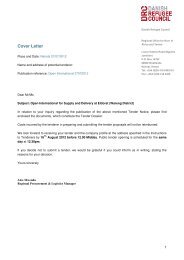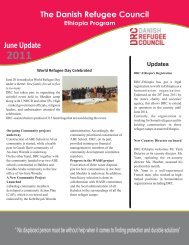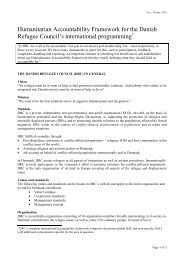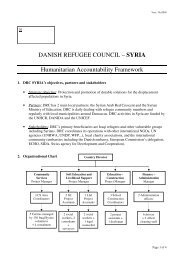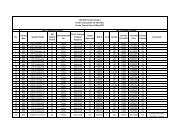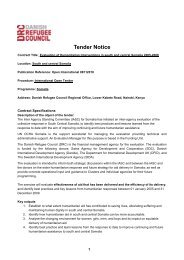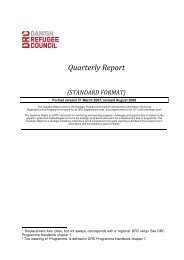Behind the Scenes, Kenya IDP Report - Danish Refugee Council
Behind the Scenes, Kenya IDP Report - Danish Refugee Council
Behind the Scenes, Kenya IDP Report - Danish Refugee Council
You also want an ePaper? Increase the reach of your titles
YUMPU automatically turns print PDFs into web optimized ePapers that Google loves.
Chapter 3: The Role of <strong>the</strong> PWGID: Added Value of a National Coordination MechanismFifth, <strong>the</strong> absence of accurate and up-to-date dataon <strong>the</strong> number and status of <strong>IDP</strong>s caused majorprotection gaps in <strong>the</strong> group’s work. The processand outcome of <strong>the</strong> government profiling exercisewas rejected by <strong>IDP</strong>s as flawed and not credibleas a significant number of affected personsclaimed <strong>the</strong>y were left out arbitrarily. There werealso allegations of corruption against <strong>the</strong> provinwasconverted to <strong>the</strong> Advocacy Sub-WorkingGroup (ASWG) and mandated to publicise andlobby for <strong>the</strong> adoption and implementation of <strong>the</strong>policy and o<strong>the</strong>r legal frameworks on <strong>the</strong> protectionof <strong>IDP</strong>s. 563.3. Key Achievements of <strong>the</strong>PWGIDSome remarkable achievements by <strong>the</strong> PWGIDwere identified by <strong>the</strong> respondents in this study.First, <strong>the</strong> PWGID as a coordination forum broughttoge<strong>the</strong>r a strong, vibrant and resilient coalitionof state and non-state actors giving prominenceto <strong>the</strong> issue of <strong>IDP</strong>s. This sense of shared purposewas created through regular meetings, sharing ofinformation and development of joint strategies.These actors played varying roles in <strong>the</strong> processlargely depending on <strong>the</strong>ir institutional mandates,<strong>the</strong> technical expertise and personal commitmentof individual PWGID members and <strong>the</strong> financialresources available from <strong>the</strong>ir respective organisations.Indeed, <strong>the</strong> PWGID managed to enlist <strong>the</strong> participationof <strong>the</strong> State in <strong>the</strong> working group through<strong>the</strong> KNCHR, MoSSP and MoJNCCA. At <strong>the</strong> fieldlevel, personnel from <strong>the</strong> Provincial Administrationchaired <strong>the</strong> field-based PWGID meetings.This elevated <strong>the</strong> status of its work and gave it <strong>the</strong>assurance of government support, and to a greatextent allowed <strong>the</strong> government to recognise its coordinationand intervention mechanisms.The involvement of UN agencies in <strong>the</strong> workinggroup also enhanced its political standing. ByJanuary 2008, <strong>the</strong> Government had sanctioned<strong>the</strong> establishment of 11 UN clusters, which playeda critical role in <strong>the</strong> management of <strong>the</strong> post-electionviolence crisis. This cooperation has sinceevolved from <strong>the</strong> emergency response phase tomore long-term goals, like formulating a policyand legal framework on internal displacement.The UN agencies involved in <strong>the</strong> working groupwere UNHCR, UNICEF and UNOCHA.Ano<strong>the</strong>r remarkable achievement is <strong>the</strong> fact that<strong>the</strong> PWGID has advocated for <strong>the</strong> achievement ofdurable solutions for <strong>IDP</strong>s by monitoring and supporting<strong>the</strong> provision of assistance to <strong>the</strong> affectedcommunities and lobbying for <strong>the</strong> recognitionof o<strong>the</strong>r categories of <strong>IDP</strong>s (in addition to thosedisplaced by 2007/2008 post-election violence).Stakeholders have also managed to identify <strong>the</strong>ircommon interests through <strong>the</strong> PWGID, <strong>the</strong>rebybringing consensus and commitment and helpingbuild a common front in intervention. The grouphas thrived despite <strong>the</strong> diversity of competenciesand expertise dictated by <strong>the</strong>ir mandates.The PWGID has also facilitated timely ga<strong>the</strong>ringand dissemination of information on <strong>the</strong> protectionof <strong>IDP</strong>s. 57 A case in point was <strong>the</strong> collectionof data on <strong>the</strong> number and condition of <strong>IDP</strong>s after<strong>the</strong> 2007 post-election violence. This process wasundertaken by <strong>the</strong> MoSSP, in collaboration with<strong>the</strong> <strong>Kenya</strong> National Bureau of Statistics and <strong>the</strong>UNHCR.In addition, <strong>the</strong> state and non-state actors broughttoge<strong>the</strong>r under <strong>the</strong> PWGID have enhanced awarenessand carried out capacity-building for variousstakeholders on <strong>the</strong> protection, provision of assistanceand o<strong>the</strong>r mechanisms for durable solutions.Since 2007, <strong>the</strong> Government has acknowledged<strong>the</strong> need for training of its officers on <strong>the</strong> rights of<strong>IDP</strong>s in order to effectively provide assistance andprotection to <strong>IDP</strong>s. It has availed officers at differentlevels to attend training sessions, mostly conductedby members of <strong>the</strong> PWGID. 58Fur<strong>the</strong>rmore, <strong>the</strong> working group promoted <strong>the</strong> establishmentof child-focused initiatives in its advocacyand dissemination of information on internaldisplacement. In Molo, such initiatives weresuccessful in raising awareness on and advocatingfor child rights and <strong>the</strong> need for child protectionmechanisms in <strong>the</strong> area. This resulted in <strong>the</strong>deployment of a district children’s officer to assistwith case management of <strong>the</strong> violations of childrights. In o<strong>the</strong>r parts of <strong>the</strong> country, child-focusedDisaster Risk Reduction was piloted throughschools where children were responsible for cultivatingcrops to mitigate climate change disasters.The group also managed to highlight <strong>the</strong> protectionneeds of o<strong>the</strong>r categories of <strong>IDP</strong>s beyondthose resulting from <strong>the</strong> 2007/2008 post-electionviolence. For instance, it undertook a fact-findingmission to Turkana County with respect todrought-induced displacement. The main motivationbehind this mission was to find ways ofextending <strong>the</strong> mandate of <strong>the</strong> PWGID beyond <strong>the</strong>protection of <strong>IDP</strong>s displaced by <strong>the</strong> post-electionviolence to include <strong>IDP</strong>s resulting from naturaldisasters. 59Finally, <strong>the</strong> group supported <strong>the</strong> development of<strong>the</strong> draft Policy and Bill on <strong>the</strong> protection of andprovision of assistance to <strong>IDP</strong>s in <strong>Kenya</strong>. This wasdone as envisaged within <strong>the</strong> terms of referencegiven to <strong>the</strong> Working Group in 2009 which was reaffirmedannually and helped <strong>the</strong> group to engagein long-term interventions beyond responding to<strong>the</strong> short and medium-term needs arising from <strong>the</strong>2007/ 2008 post-election violence.3.4. Key ChallengesThe PWGID did meet some challenges. First was<strong>the</strong> lack of effective local level participation inagenda-setting of <strong>the</strong> work of <strong>the</strong> PWGID. Onerespondent lamented that <strong>the</strong> group’s agenda waswritten in Nairobi without any consultation with<strong>the</strong> field-based groups. This affected <strong>the</strong> linkagebetween <strong>the</strong> work of <strong>the</strong> national and field-basedgroups and undermined feedback channels onprotection work as well as advocacy on <strong>the</strong> policyframework. 60 Even though <strong>the</strong> advocacy sub-groupof <strong>the</strong> PWGID remained <strong>the</strong> most active unit inpolicy work, it lacked representation at <strong>the</strong> fieldlevel and had to rely on reports from field officersto inform its advocacy interventions 61 . Consequently,field-based stakeholders were concernedabout <strong>the</strong> poor participation of <strong>IDP</strong>s at <strong>the</strong> meetingsdue to inadequate facilitation. They were alsoconcerned about <strong>the</strong> failure by key state actors toattend <strong>the</strong>ir meetings so as to respond to emergingissues.Secondly, limited financial resources coupled withbureaucratic processes, both at <strong>the</strong> national andfield levels, affected <strong>the</strong> extent of participation anddecision-making within <strong>the</strong> group. The burden offacilitating meetings and related activities wasoften left to a few organisations, <strong>the</strong>reby limitingcollective ownership of projects within <strong>the</strong> group.This often affected working relationships betweenparticipating organisations and prevented somefrom taking positions on vital issues. Tied to thiswas <strong>the</strong> “politics of visibility” which sometimesencouraged unhealthy competition amongst <strong>the</strong>members.Thirdly, <strong>the</strong> group suffered from a problem of coordinationat <strong>the</strong> national and local levels, whichcould be attributed to <strong>the</strong> lack of a full-time secretariatto run <strong>the</strong> working group. Additionally, <strong>the</strong>lack of a definite policy on internal displacementto inform such coordination led to occasional conflictsbetween <strong>the</strong> MoSSP and o<strong>the</strong>r governmentministries. This was particularly apparent in <strong>the</strong>emergency phase of <strong>the</strong> post-election violenceas <strong>the</strong> Ministry of Provincial Administration andInternal Security and <strong>the</strong> MoSSP jostled for controlof <strong>the</strong> resources directed to humanitarianresponse and in <strong>the</strong> resettlement phase between<strong>the</strong> MoSSP and <strong>the</strong> Ministry of Lands in regard tofunds for <strong>the</strong> purchase of land to resettle <strong>IDP</strong>s.Fourth, <strong>the</strong> high turnover of persons seconded fromparticipating organisations to participate in <strong>the</strong>meetings of <strong>the</strong> working group affected <strong>the</strong> leadershipand continuity of operations. Some memberstook time to familiarise <strong>the</strong>mselves with <strong>the</strong>group’s agenda, and as such could not participateoptimally in <strong>the</strong> work of <strong>the</strong> working group, whileo<strong>the</strong>rs did not stay long enough to have impact ondecision-making within <strong>the</strong> group. This affected<strong>the</strong> output of <strong>the</strong> group especially on matters thatrequired prompt and effective decision making. 6214<strong>Behind</strong> <strong>the</strong> <strong>Scenes</strong> – Lessons Learnt from Developing a National Policy Framework on Internal Displacement in <strong>Kenya</strong> 15






